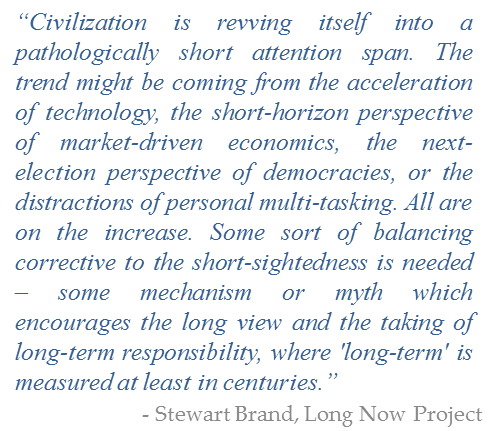From the “Here and Now” to the “Long Now”: Embedding a Long View into Decision Making
by Greg Heist, Chief Innovation Officer, Gongos, Inc.
The mega drought that has plagued California over the past four years has gained global attention. As the much-hoped-for relief from this water crisis evades Californians, increasingly austere usage restrictions are quickly becoming a fact of life for more than 12% of the U.S. population.
While we have yet to see the ultimate implications of this crisis play out for California and the rest of the U.S., there is an important—and little-known—fact that puts it all in perspective. Climate scientists are in general agreement that the 20th century was the wettest for Californians in the past 1,000 years. From this millennial perspective, the 31st state is categorically a desert, unfit to support the population (and infrastructure) that built up during the climatological anomaly that was the 20th century.
Through this lens, it’s clear that decisions that accelerated the rapid development of California reflected short-term thinking at the expense of comprehending a significant longer-term reality. Given the fact that a majority of fruits, vegetables and nut crops are grown in California, we all may have an unfortunate front-row seat to the fallout if water supplies continue to regress to their historical norms.
It is certainly possible that future generations will look back on this crisis and say, “What were they thinking when they moved 35 million people into a desert?!?”
However, the thinking that helped create this crisis isn’t an outlier. It’s often the norm in the spheres of public policy, energy policy…and yes, corporate decision making.
The questions we need to ask ourselves are “Why is our bias towards the short-term?” and “How can we embed long-view thinking into organizations so that we don’t find ourselves in similar crises?”
The Three Key Drivers of Short-Term Thinking
1. The psychology of stimulus-response
To begin, our collective focus on the here and now is at least partially rooted in the powerful psychological relationship between stimulus and response. As B.F. Skinner’s behavioral research shows, when we see a piece of chocolate, our salivary glands prepare our mouth for what the chocolate will taste like when we actually consume it. Experience teaches what to expect when that chocolate reaches our mouth, making it an easy (short-term) fix when we’re having a bad day. Similarly, organizations become conditioned to make decisions in ways that elicit a predictable response as well, such as “We’re falling short of our quarterly forecast, so let’s discount this chocolate 25% because we know it will quickly produce a spike in sales.”
2. Short-term incentives dominate the corporate landscape
Furthermore, an important dimension in our short-term orientation is related to incentives and rewards. Corporations have become increasingly beholden to the demands of investors to hit quarterly revenue and profitability targets. Missing those targets have significant repercussions on stock prices and executive compensation tied to meeting quarterly or annual financial performance metrics. Research conducted among C-Suite executives by McKinsey in 2013 showed that, although 86 percent of executives believed that using a longer time horizon to make decisions would positively affect corporate performance, 63 percent said the pressure to demonstrate short-term financial performance had increased over the past five years. These powerful pressures to achieve short-term performance create conflicts in decision-makers that aren’t easy to resolve.
3. Ambiguity about the future sends us fleeing to the comfort of the here and now
One of the other defining characteristics of modern business (and the lives of consumers) is, as we have discussed in previous posts, pervasive ambiguity and uncertainty. Disruptive market forces, rapidly shifting customer tastes and our increasingly interconnected global economy makes the future even more difficult to predict than ever. As a natural consequence, it’s tempting to focus on making decisions based on the relatively clear near term rather than trying to peer into the murkier future. We make decisions like this every time we get behind the wheel on a foggy morning. However, just because we can cautiously navigate our 5,000 pound vehicles with such limited visibility doesn’t make it a safe long-term bet. By the same token, executives should feel similarly uneasy making decisions so heavily weighted on the near term just because the future is increasingly ambiguous.
An Antidote to Short Term Thinking: The Long Now Philosophy
Stewart Brand, author of The Whole Earth Catalog is an environmentalist who has spent his life evangelizing the power of humanity and technology to create a sustainable future for the earth. In 1996, he and a group of other futurists founded the Long Now Foundation. As Wikipedia cites, The Long Now Foundation “aims to provide a counterpoint to what it views as today’s “faster/cheaper” mindset and to promote “slower/better” thinking.

One of the core projects of the Long Now Foundation is the design and construction of the 10,000 Year Clock. This clock is intended to operate independently for 10,000 years, with its “second hand” moving once per year, its “minute hand” moving every century and an “hour” advancing every thousand years. The symbolism is compelling, as it calls us to disruptively re-think our perception of time, aligning it more to the vantage point of the planet rather than our incredibly brief human lifespans.
The Long Now Foundation also supports projects dedicated to the preservation of languages that could become extinct over time, and development of server technology to enable long-term archiving of critical knowledge and data from our current era for posterity.
It’s tempting to look at the Foundation’s initiatives as the love child of ivory tower idealism and hubris. But looking below the surface, the Long Now philosophy offers an important antidote for the multi-tasking, attention-deficit corporate status quo.
Let’s explore three ways we can build a long-term counterbalance to the gravitational pull of short-term oriented decision making.
4 Ways to Bring the “Long Now” to “Here and Now” Decisions
1. Articulate a 100-year corporate vision
A foundational step to integrating very long-term thinking into decision making is the articulation of a 100-year vision for the organization. While an admittedly daunting task, developing such a long-term vision makes an important statement to the company. It declares that you plan on being a thriving entity that stands the future challenges currently unimagined. It speaks to the fact that the organization will be a positive part of the community, the environment, and the lives of the great grandchildren of your employees and customers. In short, it tells everyone that you’re not only making decisions that will not only help you profit now, but also ensure you’re building a sustaining legacy for the future.
2. Play chess, not checkers
Chess isn’t the “game of kings” for nothing. For centuries, kings, generals and tsars have played the game to develop their logical reasoning abilities and to hone their strategic and tactical skills. Like a great chess master, decision makers need to think several moves ahead, making a choice today that already encompasses the likely competitive reverberations that have yet to occur. Sun-Tzu said it best when he said, “Victorious warriors win first and then go to war, while defeated warriors go to war first and then seek to win.” We need to build similar future-oriented thinking into that next new product, campaign and strategic alliance.
3. Embed organizational altruism into your cultural DNA
When you’re at a company for two years and likely won’t spend your entire career there, it’s tough to give such a long-term view much weight to decisions you make. That is, unless you cultivate a type of altruism into your corporate values. This value makes it explicit that, “We’re an organization that won’t make a short-term decision that doesn’t have long-term benefits”. It also means that leaders need to incentivize thinking and behaviors that are in line with that value (as well as identify people who aren’t).
4. Consciously advocate for the very long term
Finally, organizations need to be conscientious about considering critical strategic decisions given the organization’s 100-year vision. When weighing critical inflection points, the Long Now philosophy needs to be voiced and advocated for. It can be as simple as asking the question, “does this opportunity help us be more resilient in light of an unknowable future?” Or, it can take the form of, “in what ways does this make our organization part of creating a sustainable future for ourselves and the world of our children’s children?”
Regardless of how you formulate that question, simply asking it will provoke some lively debate about the implications of critical decisions from a very long-term perspective. In doing so, your organization will have taken a critical step in breaking out of the overwrought “here and now” and factoring the Long Now into creating an organization with extraordinary staying power.
[To receive a quarterly email of our latest thinking, subscribe below.]SUBSCRIBE
